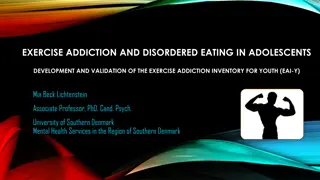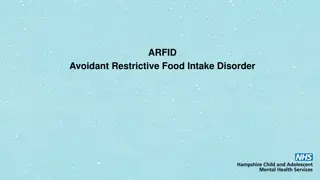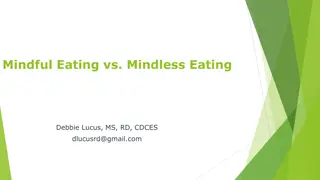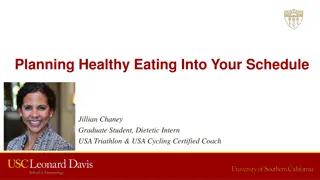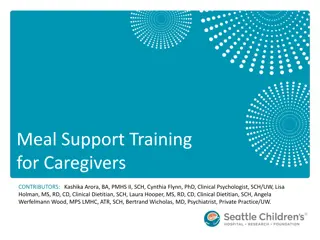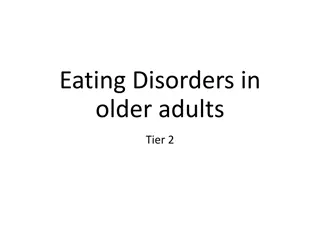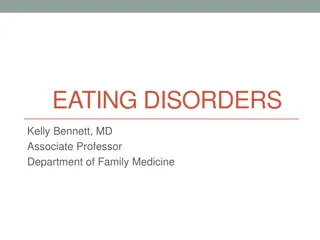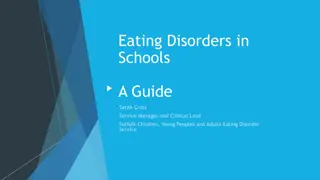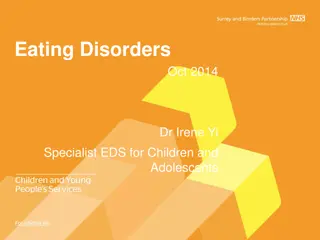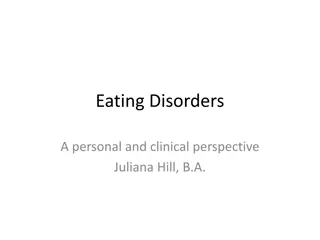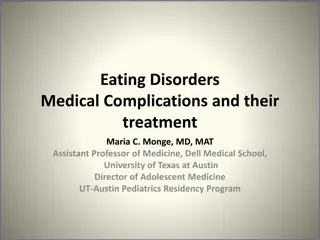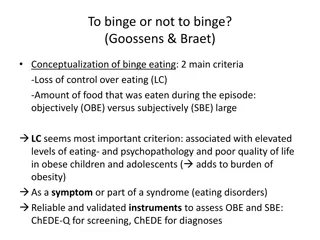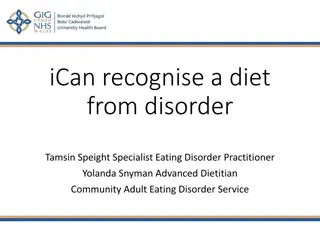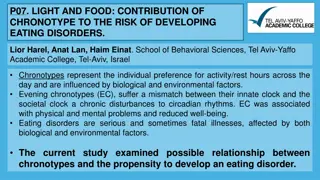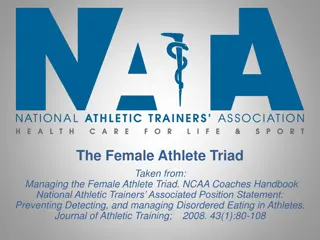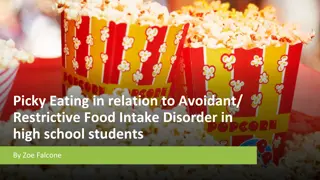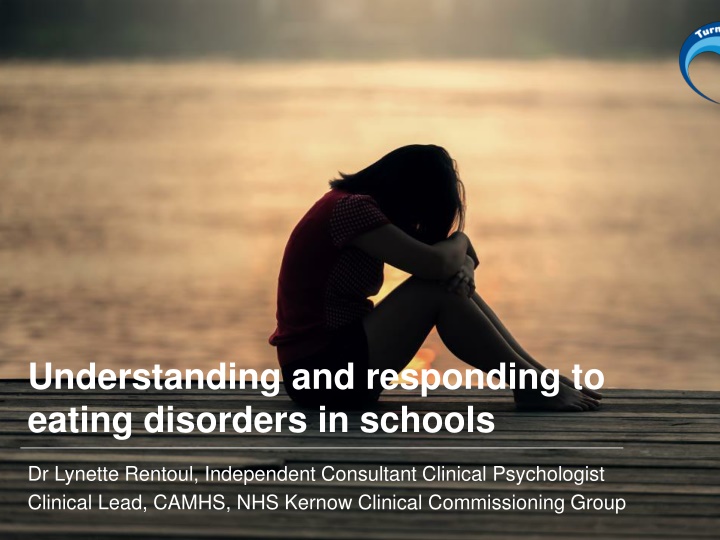
Responding to Eating Disorders in Schools: Key Points from Dr. Lynette Rentoul
Discover insights on eating problems, disorders, and how they manifest in children and young people. Learn about the types of eating disorders, who is at risk, and the importance of early intervention in schools.
Download Presentation

Please find below an Image/Link to download the presentation.
The content on the website is provided AS IS for your information and personal use only. It may not be sold, licensed, or shared on other websites without obtaining consent from the author. If you encounter any issues during the download, it is possible that the publisher has removed the file from their server.
You are allowed to download the files provided on this website for personal or commercial use, subject to the condition that they are used lawfully. All files are the property of their respective owners.
The content on the website is provided AS IS for your information and personal use only. It may not be sold, licensed, or shared on other websites without obtaining consent from the author.
E N D
Presentation Transcript
Understanding and responding to eating disorders in schools Dr Lynette Rentoul, Independent Consultant Clinical Psychologist Clinical Lead, CAMHS, NHS Kernow Clinical Commissioning Group
What is an eating problem? An eating problem is when eating habits become unhealthy -such as persistently eating too much or too little It can be scary when body changes in teens no control? Unfamiliar? This can be normal and usually passes with time Many children try dieting for first time in teens but when this becomes unhealthy, putting physical or mental health at risk, it becomes an eating problem. Self-conscious about body shape/changes in the eyes of others It is becoming more common for younger children to have eating problems & disorders (especially ARFID avoidant/restrictive eating . Whatever age an eating problem is not just about food, it is also about the feelings and emotions that cause or trigger it. Eating problems become eating disorders if behaviour meets criteria for diagnosis of ED
What do eating problems include? Markedly restricting food intake, anorexia -with weight loss Compulsive overeating or binge eating (BED) Overeating followed by purging (including misuse of laxatives; over exercise or making oneself sick) bulimia. May be no weight loss or gain. Avoidant and restrictive eating (ARFID), e.g. only eating food of particular texture or colour; or only eating limited range of food with or without weight loss (often with LD or ASC) Unhealthy attitudes to food including secretive, shameful or guilty attitudes/ behaviour to food. Underlying eating problems are marked emotional, sensory and relationship problems that need to be understood and attended to.
What are Eating Disorders? Eating problems become Eating Disorders when child s behaviour meets the criteria for diagnosis (persistent, severe, marked impact on health and functioning) As child's body changes during adolescence it can be scary time for child; this usually passes but for some their anxiety leads to marked problems with food & control. Child may try dieting, -but if child is not eating balanced diet over longer period of time, it becomes very serious Eating problems are not just about food they are about difficult things in their lives and about painful feelings, which they can t express, face, process or resolve. In EDs YP has significant concerns about weight & shape; except ARFID when the drive is avoidance of certain foods Focusing upon food can be a way of disguising problems (even from child themselves). Support from safe, attuned, compassionate adults is vital
Who develops an eating disorder? Children more likely to develop an eating disorder between ages 12-25 years -puberty (but very young children can develop wide range of eating problems e.g. ARFID) Children from all walks of life can develop an eating disorder from all cultures, classes, religions, ethnic groups Girls are up to 10 times more likely to get an Eating Disorder (but becoming more common in boys) Increased risk: parents who have obsessive interest in weight; peer pressure; undue interest and concern with being popular and attractive; hatred of one s body; overwhelmed by worries that cannot be understood and processed; limited coping skills; Perfectionist; black and white thinking Many children who develop eating disorders are not known to any services or have any clear triggers for their difficulties.
In the words of a child When I was younger, I thought I had discovered something that was just for me. Something that gave me hope and reassurance when life felt tough. I thought it could teach me everything I needed to know and could make me feel good about myself. That something was anorexia. But in reality it couldn t. In reality, it sucked me into a manipulative game
Why do children develop eating problems? (Not including ARFID) Feeling out of control believe body is the one thing they can control (especially in teens when pubertal changes are so great) Trying to be popular and confusing looking slim like models or celebrities with being attractive or successful; role of social media Feeling that you aren t good enough (longs for popularity) Hating you body (including after something has happened to you or if you have been abused). Having very unrealistic view of body. Longing to achieve an unrealistic body image (the perfect body Starting a diet and not being able to stop; Carrying on not eating after an illness; having a fearful incident, such as choking/sick Compulsive overeating, and not able to stop (longing for comfort, but never feeling satisfied). Overwhelmed with strong feelings of confusion and distress that can t be expressed, faced or managed (controlling their body offers some sense of control). Distress expressed through body Family members who worry obsessively about weight - risk
Risk factors for eating disorders include: Perfectionist personality Personality that needs to be in control; fears out of control Difficulty in coping with change Life experiences, e.g. bullying or constant teasing Harmful early life experiences (including abusive ones) Physical illness prior to developing ED; including los of appetitive. A close relationship with someone who has an eating disorder Having parent who is overly concerned about body shape/weight Strong beliefs about the value of being thin Longing to have perfect body shape as part of being popular Some young people with risk factors may not develop ED; some who develop ED do not possess risk factors; no single factor causes ED
Anorexia: what is it? An eating disorder is where you have extreme fear of gaining weight, so eat less and less. It is a serious MH problem Eating less and less; Exercise too much on regular basis Feeling panicky about eating in front of others or having a big meal (which is really a normal size meal) Feeling fat, -though people tell you that you re too thin. Very unrealistic and inaccurate view of one s body shape/size Obsession with body image, comparing body to others Low mood and irritability Lying about eating when you haven t Trying to lose weight through other ways (self-induced vomiting; diuretics; laxatives). Disgust at fat body shape
Anorexia : Physical changes Losing lots of weight quickly Periods stopping (or being unable to have an erection) Feeling cold all the time Poor sleep or concentration Unexpected soft hair growth on body parts (languo hair)
Bulimia: what is it? Cycles of overeating (binging), and then making yourself sick (or diet pills) to get rid of the food Thinking obsessively about weight Binge eating and preoccupation with eating; longing to fill with food followed by feelings of disgust and purging. Vomiting or taking laxatives Exercising too much on regular basis Isolating yourself; low mood Losing interest in things and people Changes in periods Brittle bones in longer term Stomach cramps; feeling weak and tired Feeling helpless and out of control
Compulsive overeating (binge eating): What is it? Feeling compelled to eat even when not hungry, or can t stop eating when they have had enough food. Unable to feel satisfied; longing for comfort of feeling full. Regularly eating quicker than usual Eating when full Eating when not hungry Eating alone or in secret Overeaters often feel upset or guilty after these activities; they often feel driven to do it, even though they know they shouldn t. Often feel out of control in relation to eating. Sometimes feels as though they have an addiction to food .
ARFID (more common among CYP with ASC and LD); starts early in life Apparent lack of interest in food or eating; eats very few foods Not able to recognize feelings of hunger or thirst Avoidance based on sensory characteristics of food (texture; colour; smell; flavour); will not eat unfamiliar foods (even if hungry) Concern about being sick/choking or aversive consequences of eating Preference for certain textures and colour and familiar foods (including familiar brands) Highly restrictive food intake in terms of amount and variety Significant weight loss (but also gain; or normal range) Significant nutritional deficiency; marked health risks Dependence on enteral (external) feeding Marked interference with psychosocial functioning
Common warning signs of eating problems and Eating Disorders Obsession with food/ excessive interest in food Rapid weight loss/or weight gain Buying and making food for others constantly Moving about all the time (even when sitting down, moving limbs) Eating with a teaspoon or using very small bowls for meals; or eating very quickly (not hungry) Wearing very baggy clothes Turning veggie/vegan (restrictions) Food rituals/ very secretive eating Difficulty concentrating/sleeping Hair loss (notice clothes covered in hair); dizziness on standing Notice children who seem cold and always sit next to radiator (blue hands). Poor circulation Notice children who are often unusually tired Dieting and control of foods are key concerns Social withdrawal/ mood swings
Importance of getting getting help In the words of a young person: Support is available: it is scary asking for support. I know that. You don t want people to interfere who make you fat. But they won t. They just want to help. They offer hope .
10 truths about eating disorders 1. People with ED may look healthy yet may be very unwell 2. Families are not to blame; they can be best allies to YP in treatment 3. An ED diagnosis is a health crisis that disrupts personal and family functioning. 4. EDs are not choices, but illnesses 5. EDs affect people from all backgrounds
10 truths about Eating Disorders (continued) 7. EDs carry increased risk for suicide and medical complications 8. Genes alone will not predict who will develop an Eating Disorder; genes & environment play important roles in development of eating disorders (biological, psychological and social) 9. Full recovery from eating disorder is possible. 10. Early recognition and intervention are very important in improving wellbeing and outcomes.
What is helpful when responding to eating problems: Be attuned and compassionate Don t put pressure on young person to eat this can have an adverse effect. Even when eating, there are ongoing psychological problems, that need to be addressed. Be empathic, patient, non-judgemental - listen and care. Stay supportive, even if young person pushes you away. See the person behind the eating difficulties- focus on feelings, rather than problems in eating. Avoid talking about child s appearance. Accept young person s mixed feelings they might hate what they are doing, even though at the same time, they feel they need it, to maintain control. Learn as much as you can about eating disorders; it is important to understand that there are emotional difficulties underpinning them. Voice the concerns you have, listen to the child s views on what they want to happen. Be emotionally available adult . Notice changes in child. Recognise how hard it is for child to talk to you it takes a lot of courage to discuss eating problems. Encourage young people to get help and support as early as they can, and not wait until things get worse.
What is not helpful when responding to eating problems? Don t assume theyoung person s difficulties are the parent s fault and judge them. Children need families to support their recovery. Don t simply ask them to abandon eating problems. Their strategies to maintain control are seen as a safety net in their life, which will take time to reshape and shift Don t invalidate distress, even if their attitudes to food seems irrational to you. It feels very real to the young person and not irrational. Don t expect YP to get to healthy weight without helping them with their mental help and emotional wellbeing Don t comment upon weight or food, it is not helpful. More helpful to connect with the young person behind the problem, including their social and emotional problems and challenges. Don t ask a young person to promise to just eat something ; it is really unhelpful. They need help with underlying problems and struggles. Don t comment upon appearance (even saying you look better ); this may cause concern. It is OK to notice distress. Forch
Young peoples views on helpful school approaches Notice changes in YPs behaviour, including: weight loss and eating patterns. Don t be afraid to talk with young person. Provide non stigmatising environment in relation to mental health and eating disorders School staff to have a better working knowledge of the early signs of eating disorders. Be aware that eating disorders are mental health problems, not just about eating. Support the underlying emotional difficulties Don t make it easy for young people to skip meals at school. Make sure there is enough time to eat lunch in confortable setting See the person behind the eating disorder; do not simply focus on the eating problems A safe comfortable environment within the school to go to if distressed. Make sure there is a member of staff that the young person can go and talk to.
Young peoples views on unhelpful school approaches Inadequate time and space for eating lunch (easy to miss meals). Make sure children with special packed lunch do not stand out (allow them to pick up with other packed lunches) Always talking about food and losing weight. Sports staff and science staff talking about BMI and weight loss Constantly talking about healthy eating, rather than balanced eating. Problem of cal. counting in classes Commenting upon appearance (without concern for person s wellbeing) A stigmatising environment with a lack of mental health awareness and understanding of eating disorders.
Young peoples 10 top tips for schools Make sure there are supportive, trusted and emotionally available staff in school and that children and staff know who they are Don t be afraid to take the first step and talk with the YP and family. Be brave talking to young person when you notice warning signs. Have a support and Safety Plan in place at school (use the Health and Wellbeing Road Map developed by YP Cornwall). It is important to remember that Eating Disorder is a mental health, as well as physical problem. Support young people as early as you can. Non Have regular check-ins with students known to be struggling (even if they appear OK). Remember that Eating Disorder is often secret problem-young people can be very secretive. Treat young person with respect and adopt a non- judgmental approach. stigmatizing environment; Problems of talking about BMI and cal. counting in classes Talk about balanced eating rather than healthy eating
Support for children with eating problems: links with other agencies I-Thrive framework supports mental health pathways across all levels of care and treatment. Within this framework there are different levels of support for children (Advice and Information; Primary Health; Bloom; third sector agencies; PMHT; Specialist CAMHS; social care; Headstart/TIS). Bloom provides advice and guidance for schools and the local network of care and support. TIS provides relevant attachment based guidance. Mental Health Workers will be embedded in some Primary schools
Cornwall I-Thrive Framework for eating problems and disorders: pathways of support and treatment BLOOM; Voluntary Sector; YPC; School nurses; MHST PMHT Support and guidance in schools; TIS staff; SENCo Ed. Psych School nurses Public Health Coping and advice Getting help Getting more help Risk support Managing risk; Social Care and CAMHS; safety plans; crisis & outreach teams Specialist CAMHS/CAPs; CEDS; In-patient care

